Preliminary Model-Based Evaluation of Water Conservation Strategies in a Semi-Arid Urban Zone
Abstract
:1. Introduction
2. Review of the SWMM Application to Arid and Semiarid Zones
3. Materials and Methods
3.1. Study Area
3.2. Selected Storm Events
3.3. Simulated Urban Development Scenarios
3.3.1. Conventional Urban Development Scenario (A)
3.3.2. Urban Development Scenario with LID Practices (B)
- Porous pavement. This LID solution was hypothetically implemented in 100% of the sidewalks and pedestrian paths and 70% of parking lots and paved roads within the campus. It was contemplated that the remaining 30% would be destined for the transit and parking of heavy vehicles. The SWMM software assumed that the porous pavement functioned as a continuous system and without obstruction problems.
- Rain barrels. It was proposed that rain barrels capture 50% of runoff generated on the campus buildings’ roofs with a maximum area of 5125 m2 and a minimum area of 96 m2. The remaining 50% of the harvested runoff was directed to permeable surfaces (i.e., vegetated and bare soils; Figure 3). The capacity of each rain barrel was established according to the catchment area of each building roof as follows: 2500 L for 90–250 m2 roofs; 5000 L for 250–500 m2 roofs; 10,000 L for 500–1000 m2 roofs; 15,000 L for 1000–3000 m2 roofs; 20,000 L for 3000–4500 m2 roofs; and finally 22,000 L for 4500–5500 m2 roofs. These capacities are based on commercial devices, not in their desirable dimensions, because it would require more infrastructure changes.
- Bioretention cells and infiltration trenches. Bioretention cells were located to intercept the main runoff conveyances generated in the campus; they were preferably situated in existing vegetated spaces, while infiltration trenches were placed in locations where soils were left bare. For the dimensioning of bioretention cells and infiltration trenches, it was considered that 10% of the available area (vegetated and bare soils) was destined for these LID technologies [26]. We proposed that bioretention cells and infiltration trenches have storage volumes between 350 to 1500 L, depending on the available surface. The surfaces selected in the SWMM software ranged between 18 and 50 m2 to capture up to 50% of the runoff.
3.3.3. Realistic Urban Development Scenario with LID Practices I
3.4. SWMM Model Setup
3.4.1. Hydrological and Hydraulic Model Construction
3.4.2. Graphic Representation
3.4.3. Parameter Definition
3.4.4. Simulation Execution
3.5. Field Water-Quality Assessment
4. Results and Discussion
4.1. Model Simulation
4.2. Simulation and Field Assessment of Runoff Quality
5. Conclusions
Supplementary Materials
Author Contributions
Funding
Institutional Review Board Statement
Informed Consent Statement
Data Availability Statement
Acknowledgments
Conflicts of Interest
References
- Lizárraga-Mendiola, L.; Vázquez-Rodríguez, G.A.; Lucho-Constantino, C.A.; Bigurra-Alzati, C.A.; Beltrán-Hernández, R.I.; Ortiz-Hernández, J.E.; López-León, L.D. Hydrological design of two low-impact development techniques in a semi-arid climate zone of Central Mexico. Water 2017, 9, 561. [Google Scholar] [CrossRef] [Green Version]
- Qin, H.; Li, Z.; Fu, G. The effects of low impact development on urban flooding under different rainfall characteristics. J. Environ. Manag. 2013, 129, 577–585. [Google Scholar] [CrossRef] [PubMed] [Green Version]
- Meerow, S.; Natarajan, M.; Krantz, D. Green infrastructure performance in arid and semi-arid urban environments. Urban Water J. 2021, 18, 275–285. [Google Scholar] [CrossRef]
- Ortega-Villar, R.; Lizárraga-Mendiola, L.; Coronel-Olivares, C.; López-León, L.D.; Bigurra-Alzati, C.A.; Vázquez-Rodríguez, G.A. Effect of photocatalytic Fe2O3 nanoparticles on urban runoff pollutant removal by permeable concrete. J. Environ. Manag. 2019, 242, 487–495. [Google Scholar] [CrossRef]
- Cunha, M.C.; Zeferino, J.A.; Simões, N.E.; Saldarriaga, J.G. Optimal location and sizing of storage units in a drainage system. Environ. Model. Softw. 2016, 83, 155–166. [Google Scholar] [CrossRef] [Green Version]
- Bosley, E.K. Hydrologic Evaluation of Low Impact Development Using a Continuous, Spatially-distributed Model. Master’s Thesis, Virginia Polytechnic Institute and State University, Blacksburg, VA, USA, 2008. [Google Scholar]
- Jiang, Y.; Yuan, Y.; Piza, H. A review of applicability and effectiveness of low impact development/green infrastructure practices in arid/semi-arid United States. Environments 2015, 2, 221–249. [Google Scholar] [CrossRef]
- Huang, J.; Zhang, G.; Zhang, Y.; Guan, X.; Wei, Y.; Guo, R. Global desertification vulnerability to climate change and human activities. Land Degrad. Dev. 2020, 31, 1380–1391. [Google Scholar] [CrossRef]
- Burrell, A.L.; Evans, J.P.; De Kauwe, M.G. Anthropogenic climate change has driven over 5 million km2 of drylands towards desertification. Nature Comm. 2020, 11, 3853. [Google Scholar] [CrossRef] [PubMed]
- Rabori, A.M.; Ghazavi, R. Urban Flood Estimation and Evaluation of the Performance of an Urban Drainage System in a Semi-Arid Urban Area Using SWMM. Water Environ. Res. 2018, 90, 2075–2082. [Google Scholar] [CrossRef]
- Du Toit, M.J.; Cilliers, S.S.; Dallimer, M.; Goddard, M.; Guenat, S.; Cornelius, S.F. Urban green infrastructure and ecosystem services in sub-Saharan Africa. Landsc. Urban Plan. 2018, 180, 249–261. [Google Scholar] [CrossRef]
- Soz, S.A.; Kryspin-Watson, J.; Stanton-Geddes, Z. The Role of Green Infrastructure Solutions in Urban Flood Risk Management; World Bank: Washington, DC, USA, 2016; Available online: https://openknowledge.worldbank.org/handle/10986/25112 (accessed on 27 July 2021).
- Ortiz-Hernández, J.E.; Lucho-Constantino, C.A.; Lizárraga-Mendiola, L.; Beltrán-Hernández, R.I.; Coronel-Olivares, C.; Vázquez-Rodríguez, G.A. Quality of urban runoff in wet and dry seasons: A case study in a semi-arid zone. Environ. Sci. Pollut. Res. 2016, 23, 25156–25168. [Google Scholar] [CrossRef]
- Barros, R.A.P.; Alves, R.I.A.; Hermínio, C.F.P.; Djordjević, S.; Javadi, A. Land-Use and Legislation-Based Methodology for the Implementation of Sustainable Drainage Systems in the Semi-Arid Region of Brazil. Sustainability 2020, 12, 661. [Google Scholar] [CrossRef] [Green Version]
- Zaghloul, N.A.; Al-Mutairi, B.L. Water harvesting of urban runoff in Kuwait. Trans. A Civil. Eng. 2010, 17, 236–243. [Google Scholar]
- National Water Commission (CONAGUA). National Climatological Database (Sistema CLICOM); CONAGUA: Jalisco, Mexico, 2020; Available online: http://clicom-mex.cicese.mx (accessed on 27 November 2020). (In Spanish)
- National Meteorological Service (SMN). Forecasted Weather for Municipalities (Pronóstico del Tiempo por Municipios); CONAGUA: Jalisco, Mexico, 2019. Available online: http://smn.cna.gob.mx/es/pronostico-del-tiempo-por-municipios (accessed on 4 September 2020). (In Spanish)
- Lizárraga-Mendiola, L.; Vázquez-Rodríguez, G.; Blanco-Piñón, A.; Rangel-Martínez, Y.; González-Sandoval, M. Estimating the Rainwater Potential per Household in an Urban Area: Case Study in Central Mexico. Water 2015, 7, 4622–4637. [Google Scholar] [CrossRef] [Green Version]
- Campos-Aranda, D.F. Rainfall Maximum Intensities for Urban Hydrological Design in Mexican Republic. Ing. Inv. Tecnol. 2010, 2, 179–188. [Google Scholar] [CrossRef]
- Hur, S.; Nam, K.; Kim, J.; Kwak, C. Development of runoff model FFC-QUAL for first-flush water-quality analysis in urban drainage basins. J. Environ. Manag. 2018, 205, 73–84. [Google Scholar] [CrossRef] [PubMed]
- Bigurra-Alzati, C.A.; Ortiz-Gómez, R.; Vázquez-Rodríguez, G.A.; López-León, L.D.; Lizárraga-Mendiola, L. Water Conservation and Green Infrastructure Adaptations to Reduce Water Scarcity for Residential Areas with Semi-Arid Climate: Mineral de la Reforma, Mexico. Water 2020, 13, 45. [Google Scholar] [CrossRef]
- United States Department of Agriculture (USDA). Urban Hydrology for Small Watersheds; Technical Release 55; United States Department of Agriculture (USDA): Washington, DC, USA, 1986; 164p.
- McCuen, R.H. Hydrologic Analysis and Design; Prentice Hall: Upper Saddle River, NJ, USA, 1998. [Google Scholar]
- Huízar-Álvarez, R. Carta Hidrogeológica de la Cuenca del Río de las Avenidas, de Pachuca, Hgo., México; Instituto de Geología, Universidad Nacional Autónoma de México: Mexico City, Mexico, 1993; 37p. [Google Scholar]
- Mays, L. (Ed.) Integrated Urban Water Management: Arid and Semi-Arid Regions; UNESCO-IHP, CRC Press: Paris, France, 2014; p. 50. [Google Scholar]
- Gonçalves, M.L.R.; Zisch, J.; Rau, S.; Sitzmann, M.; Rauch, W.; Kleidorfer, M. Modeling the effects of introducing low impact development in a tropical city: A case study from Joinville, Brazil. Sustainability 2018, 10, 728. [Google Scholar] [CrossRef] [Green Version]
- Mexico News Daily. Mexico City Announces Water Catchment Program For Homeowners (18 January 2019). Available online: https://mexiconewsdaily.com/news/mexico-city-announces-water-catchment-program/ (accessed on 5 August 2021).
- XP Solutions. XP-SWMM Stormwater and Wastewater Management Model: Getting Started Manual; XP Solutions: Newbury, UK, 2016. [Google Scholar]
- Rossman, L. Storm Water Management Model User´s Manual Version 5.1—EPA/600/R-14/413 (NTIS EPA/600/R-14/413b); Office of Research and Development, Environmental Protection Agency: Washington DC, USA, 2015. Available online: https://www.epa.gov/sites/production/files/2019-02/documents/epaswmm5_1_manual_master_8-2-15.pdf (accessed on 4 December 2020).
- Municipal Planning Institute (IMPLAN). Green Infrastructure Design Guidelines for Mexican Municipalities (Manual de Lineamientos de Diseño de Infraestructura Verde Para Municipios Mexicanos); IMPLAN: Hermosillo, Mexico, 2019; Available online: https://www.implanhermosillo.gob.mx/wp-content/uploads/2019/06/ManualIV3.pdf (accessed on 4 April 2021).
- American Public Health Association; American Water Works Association; Water Environment Federation (APHA/AWWA/WEC). Standard Methods for the Examination of Water and Wastewater, 22nd ed.; APHA; AWWA; WEC: Washington, DC, USA, 2012. [Google Scholar]
- Mubarak, A.; Howald, R.A.; Woodriff, R. Elimination of chloride interferences with mercuric ions in the determination of nitrates by the phenoldisulfonic acid method. Anal. Chem. 1977, 49, 857–860. [Google Scholar] [CrossRef]
- Huang, J.J.; Li, Y.; Niu, S.; Zhou, S.H. Assessing the performances of low impact development alternatives by long-term simulation for a semi-arid area in Tianjin, northern China. Water Sci. Technol. 2014, 70, 1740–1745. [Google Scholar] [CrossRef]
- Li, J.; Li, Y.; Li, Y. SWMM-based evaluation of the effect of rain gardens on urbanized areas. Environ Earth Sci. 2016, 75, 1–14. [Google Scholar] [CrossRef]
- Huo, Y.C.; Wu, X.; Luan, Q.H.; Liu, J.H.; Ma, D. Effectiveness evaluation of LIDs through SWMM: A case study of typical urban unit in Handan, China. In Proceedings of the IOP Conference Series: Earth and Environmental Science, Proceedings of the 5th International Conference on Water Resource and Environment (WRE 2019), Macao, China, 16–19 July 2019; IOP Publishing: Macao, China, 2019; Volume 344, p. 012056. [Google Scholar] [CrossRef]
- Mahmoud, A.; Alam, T.; Rahman, Y.A.; Sánchez, A.; Guerrero, J.; Jones, K.D. Evaluation of field-scale stormwater bioretention structure Flow and pollutant load reductions in a semi-arid coastal climate. Ecol. Eng. X 2019, 1, 100007. [Google Scholar] [CrossRef]
- Joshi, P.; Leitão, J.P.; Maurer, M.; Bach, P.M. Not all SuDS are created equal: Impact of different approaches on combined sewer overflows. Water Res. 2021, 191, 116780. [Google Scholar] [CrossRef]
- Asaf, L.; Nativ, R.; Shain, D.; Hassan, M.; Geyer, S. Controls on the chemical and isotopic compositions of urban stormwater in a semiarid zone. J. Hydrol. 2004, 294, 270–293. [Google Scholar] [CrossRef]
- Ivanovsky, A.; Belles, A.; Criquet, J.; Dumoulin, D.; Noble, P.; Alary, C.; Billon, G. Assessment of the treatment efficiency of an urban stormwater pond and its impact on the natural downstream watercourse. J. Environ. Manag. 2018, 226, 120–130. [Google Scholar] [CrossRef]
- Caraco, D. Stormwater Strategies for Arid and Semi-Arid Watersheds. In The Practice of Watershed Protection; Schueler, T.R., Holland, H.K., Eds.; Center for Watershed Protection: Ellicott City, MD, USA, 2000; pp. 382–391. [Google Scholar]
- Tedoldi, D.; Chebbo, G.; Pierlot, D.; Kovacs, Y.; Gromaire, M.C. Impact of runoff infiltration on contaminant accumulation and transport in the soil/filter media of Sustainable Urban Drainage Systems: A literature review. Sci. Total Environ. 2016, 569, 904–926. [Google Scholar] [CrossRef]
- Li, L.; Davis, A.P. Urban stormwater runoff nitrogen composition and fate in bioretention systems. Environ. Sci. Technol. 2014, 48, 3403–3410. [Google Scholar] [CrossRef] [PubMed]
- Komlos, J.; Traver, R.G. Long-term orthophosphate removal in a field-scale storm-water bioinfiltration rain garden. J. Environ. Eng. 2012, 138, 991–998. [Google Scholar] [CrossRef]
- Davis, A.P.; Shokouhian, M.; Sharma, H.; Minami, C.; Winogradoff, D. Water quality improvement through bioretention: Lead, copper, and zinc removal. Water Environ. Res. 2003, 75, 73–82. [Google Scholar] [CrossRef] [PubMed]
- Niazi, M.; Nietch, C.; Maghrebi, M.; Jackson, N.; Bennett, B.R.; Tryby, M.; Massoudieh, A. Storm water management model: Performance review and gap analysis. J. Sustain. Water Built Environ. 2017, 3, 04017002. [Google Scholar] [CrossRef] [Green Version]
- Baek, S.S.; Ligaray, M.; Pyo, J.; Park, J.P.; Kang, J.H.; Pachepsky, Y.; Chun, J.A.; Cho, K.H. A novel water quality module of the SWMM model for assessing low impact development (LID) in urban watersheds. J. Hydrol. 2020, 586, 124886. [Google Scholar] [CrossRef]
- Ellis, J.B.; Mitchell, G. Urban diffuse pollution: Key data information approaches for the Water Framework Directive. Water Environ. J. 2006, 20, 19–26. [Google Scholar] [CrossRef]
- Tu, M.C.; Smith, P. Modeling pollutant buildup and washoff parameters for SWMM based on land use in a semiarid urban watershed. Water Air Soil Pollut. 2018, 229, 1–15. [Google Scholar] [CrossRef]
- Zúñiga-Estrada, M.A.; Vázquez-Rodríguez, G.A.; Ramírez-Cardona, M.; Lizárraga-Mendiola, L. Mineralogical evidence of unfavorable geochemical interactions between urban runoff pollutants and filter materials in low-impact systems. J. Hazard. Mater. 2020, 390, 122136. [Google Scholar] [CrossRef] [PubMed]
- Golden, H.E.; Hoghooghi, N. Green infrastructure and its catchment-scale effects: An emerging science. WIRES Water 2018, 5, e1254. [Google Scholar] [CrossRef] [Green Version]
- Drake, J.A.; Bradford, A.; Marsalek, J. Review of environmental performance of permeable pavement systems: State of the knowledge. Water Qual. Res. J. Canada 2013, 48, 203–222. [Google Scholar] [CrossRef]

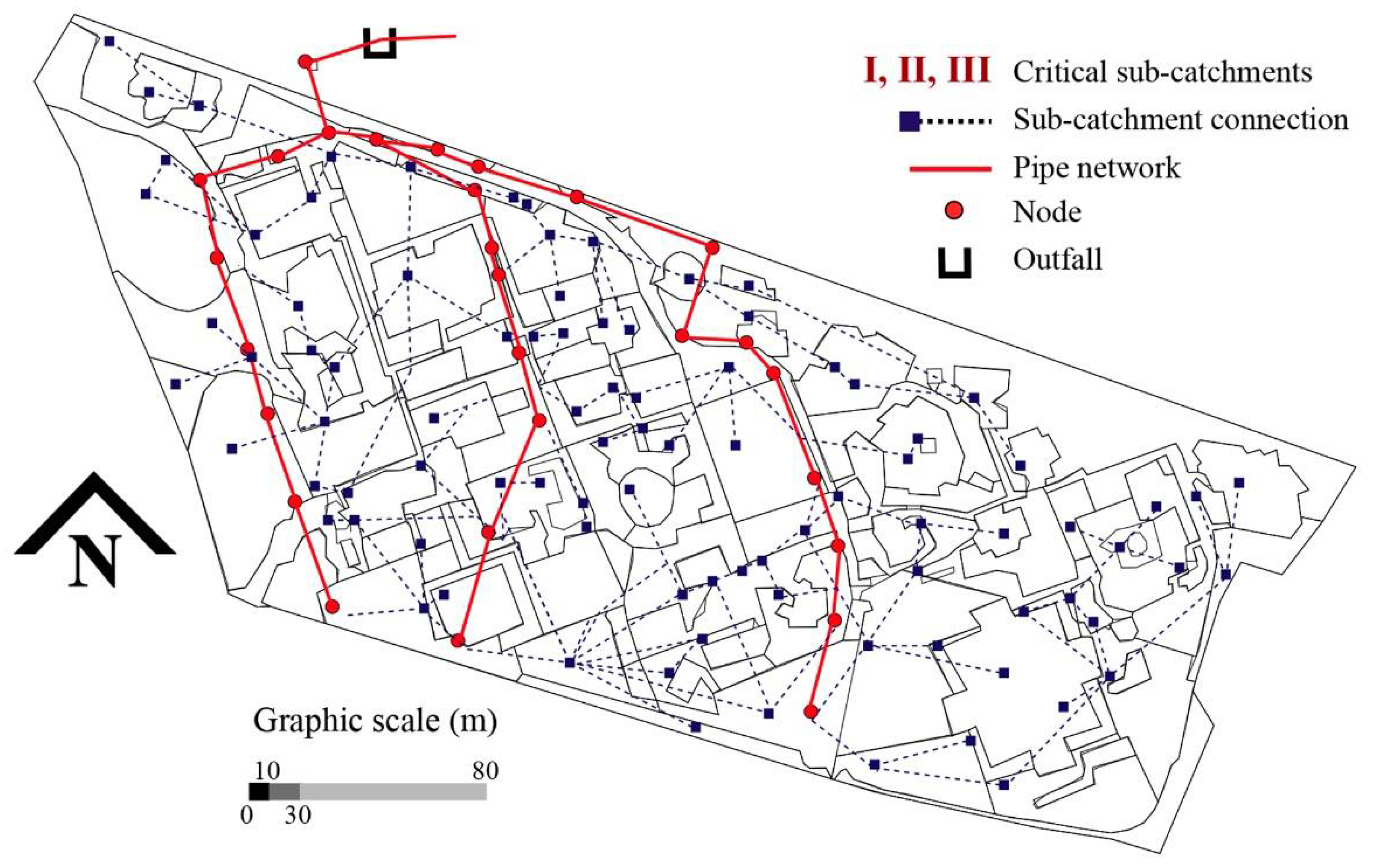
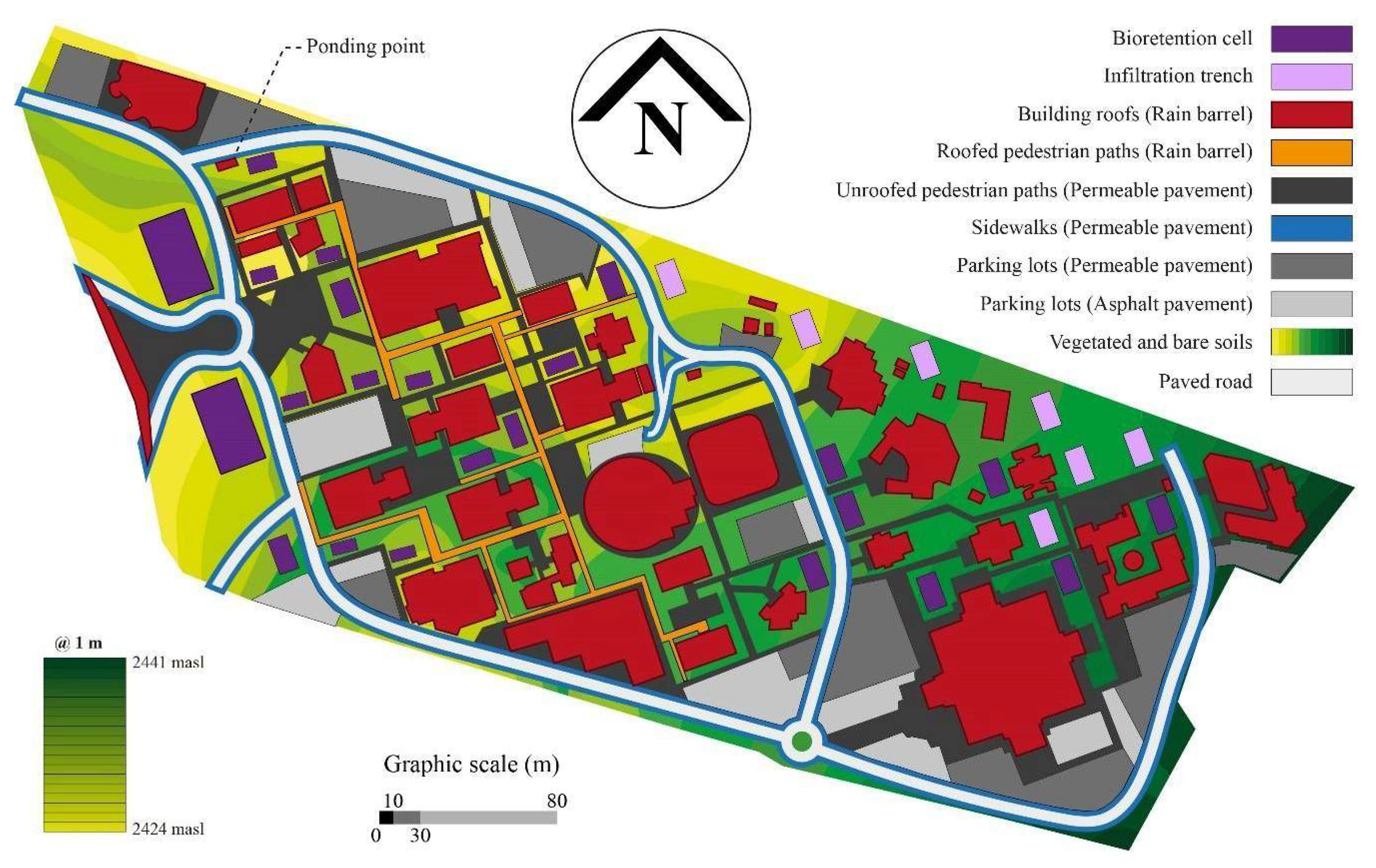
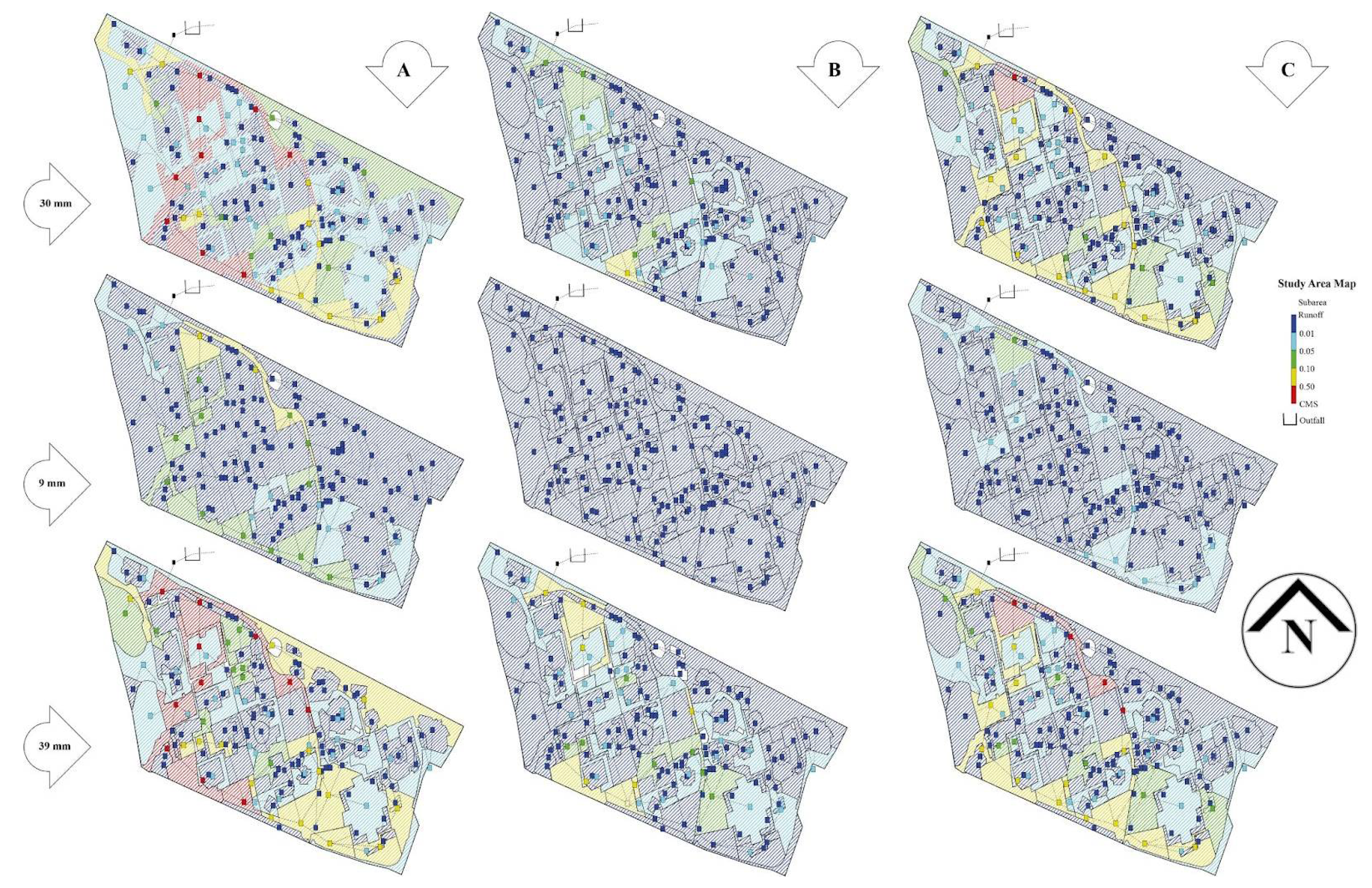

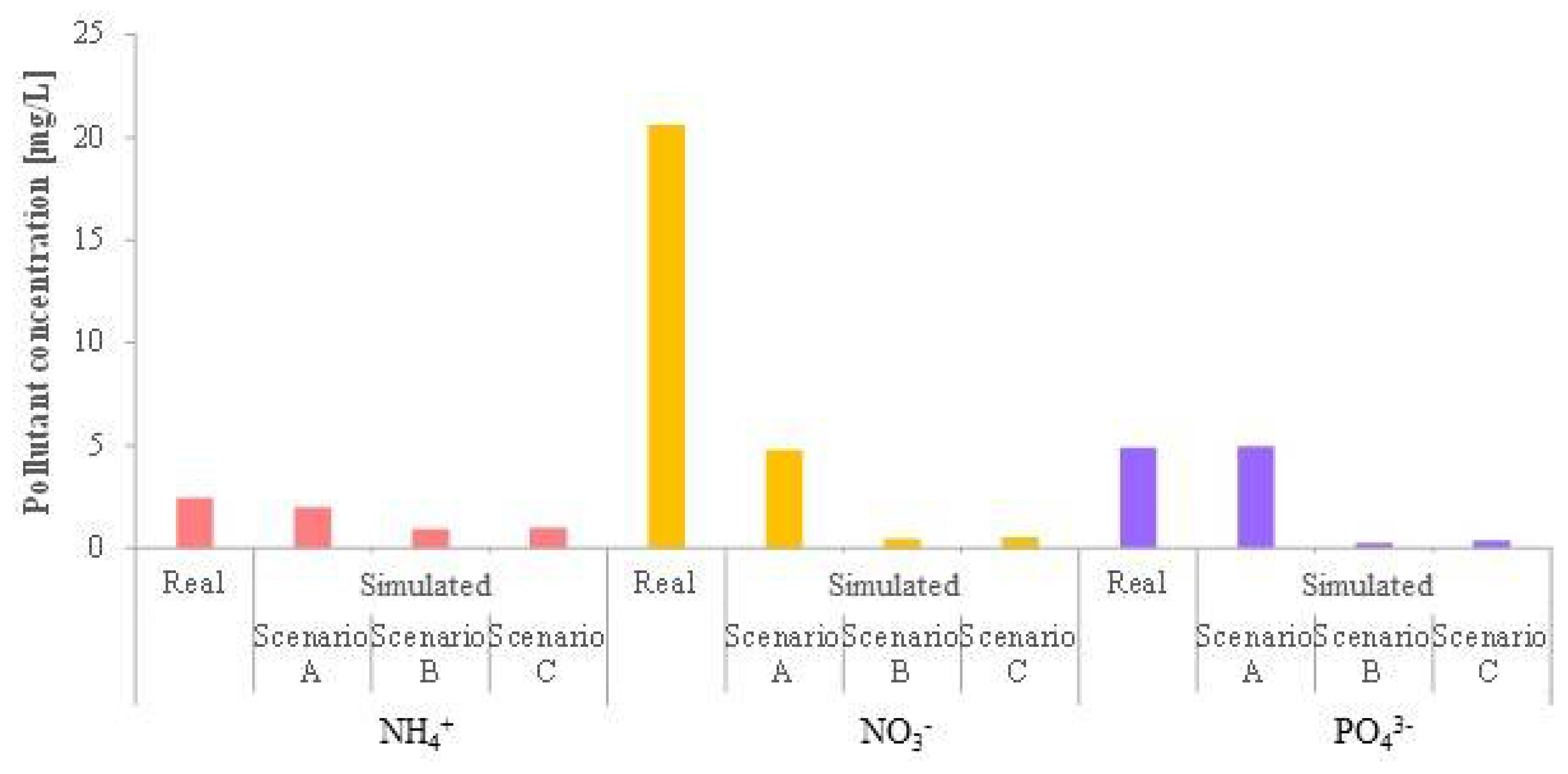
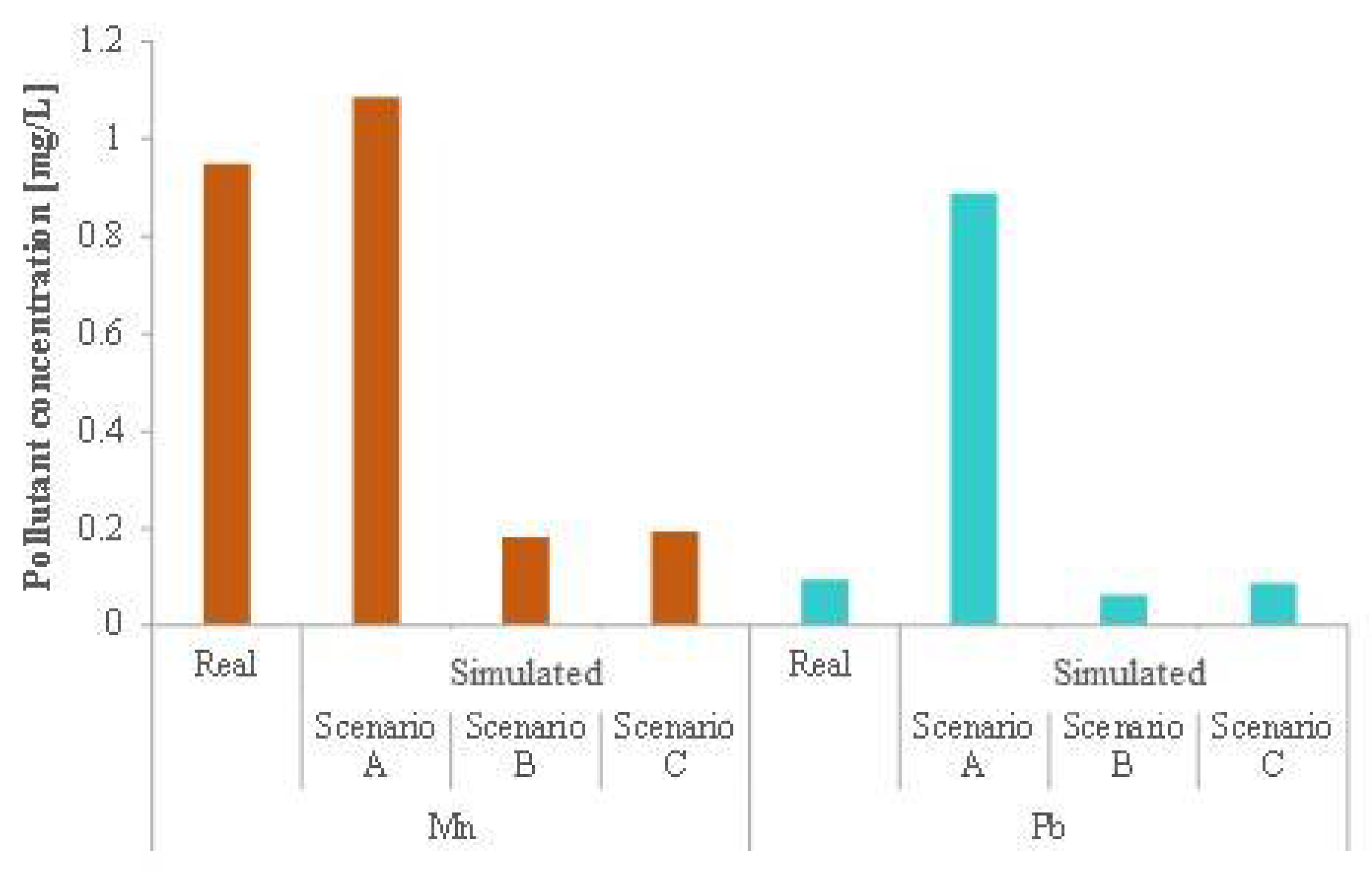
| Parameter | High Zone | Intermediate Zone | Low Zone | |||
|---|---|---|---|---|---|---|
| A1 | A2 | B1 | B2 | C1 | C2 | |
| Total surface area (m2) | 62,240.6 | 40,337.5 | 43,695 | 25,430 | 64,384.5 | 50,877.8 |
| Slope (%) | 3.6 | 4.3 | 5.8 | 2.5 | 1.8 | 2.3 |
| Soil use (m2) | ||||||
| Soil without vegetation cover | 35,392.4 | 6228.5 | 7089.4 | 11,897 | 5574 | 2112 |
| Soil with vegetation cover | 0 | 0 | 3737 | 0 | 21,336 | 19,007 |
| Asphalted surface | 9897.2 | 23,555 | 16,368 | 9631 | 22,676 | 18,719 |
| Roof catchment | 16,951 | 10,554 | 16,500.6 | 3902 | 14,798.5 | 11,039.8 |
| Average runoff coefficient (impermeable) | 0.93 | 1 | 1 | 0.87 | 0.89 | 0.75 |
| Average runoff coefficient (permeable) | 0.61 | 0.65 | 0.71 | 0.65 | 0.55 | 0.69 |
| Rainwater collection surface (m2) | 16,951 | 10,554 | 16,500.6 | 3902 | 14,798.5 | 11,039.8 |
| Runoff surface (m2) | 45,289.6 | 29,783.5 | 27,194.4 | 21,528 | 49,586 | 39,838 |
| Total area:permeable area | 01:0.6 | 01:0.2 | 01:0.2 | 01:0.5 | 01:0.4 | 01:0.4 |
| LID Device | Parameter | Default Value [mm] | Value Used in the Model [mm] | Source |
|---|---|---|---|---|
| Bioretention cell 1 | Berm height | 750 | 150 | [30] |
| Soil thickness | 500 | 400 | ||
| Storage thickness | 1500 | 300 | ||
| Infiltration trench 1 | Berm height | 750 | 350 | [1] |
| Permeable pavement 2 | Pavement thickness | 100 | 190 | [30] |
| Soil thickness | 900 | 2 |
| Sub-Catchment | Total Precipitation [mm] | Runoff 1.5 h [m3/s] | Infiltration 1.5 h [mm/h] | Peak Flow [m3/s] | |
|---|---|---|---|---|---|
| Conventional urban development scenario (A) | I | 30 | 1.23 | 0.00 | 1.35 |
| II | 30 | 1.37 | 0.00 | 1.41 | |
| III | 30 | 0.70 | 0.00 | 0.71 | |
| I | 09 | 0.14 | 0.00 | 0.15 | |
| II | 09 | 0.15 | 0.00 | 0.17 | |
| III | 09 | 0.08 | 0.00 | 0.10 | |
| I | 39 | 1.60 | 0.00 | 1.61 | |
| II | 39 | 1.84 | 0.00 | 1.93 | |
| III | 39 | 1.01 | 0.00 | 1.01 | |
| Urban development scenario with LID practices (B) | I | 30 | 0.07 | 0.21 | 0.07 |
| II | 30 | 0.07 | 0.66 | 0.08 | |
| III | 30 | 0.00 | 0.46 | 0.00 | |
| I | 09 | 0.00 | 0.20 | 0.00 | |
| II | 09 | 0.00 | 0.21 | 0.00 | |
| III | 09 | 0.00 | 0.19 | 0.00 | |
| I | 39 | 0.15 | 0.21 | 0.15 | |
| II | 39 | 0.16 | 0.84 | 0.18 | |
| III | 39 | 0.01 | 0.64 | 0.03 | |
| Realistic urban development scenario with LID practices (C) | I | 30 | 0.57 | 0.00 | 0.59 |
| II | 30 | 0.14 | 1.66 | 0.15 | |
| III | 30 | 0.18 | 0.00 | 0.29 | |
| I | 09 | 0.06 | 0.00 | 0.07 | |
| II | 09 | 0.02 | 1.87 | 0.02 | |
| III | 09 | 0.01 | 0.00 | 0.03 | |
| I | 39 | 0.85 | 0.00 | 0.90 | |
| II | 39 | 0.22 | 1.64 | 0.24 | |
| III | 39 | 0.36 | 0.00 | 0.46 |
Publisher’s Note: MDPI stays neutral with regard to jurisdictional claims in published maps and institutional affiliations. |
© 2022 by the authors. Licensee MDPI, Basel, Switzerland. This article is an open access article distributed under the terms and conditions of the Creative Commons Attribution (CC BY) license (https://creativecommons.org/licenses/by/4.0/).
Share and Cite
Zúñiga-Estrada, M.A.; Lizárraga-Mendiola, L.; Bigurra-Alzati, C.A.; Aldana-Alonso, S.E.; Ramírez-Núñez, J.S.; Vázquez-Rodríguez, G.A. Preliminary Model-Based Evaluation of Water Conservation Strategies in a Semi-Arid Urban Zone. Land 2022, 11, 101. https://doi.org/10.3390/land11010101
Zúñiga-Estrada MA, Lizárraga-Mendiola L, Bigurra-Alzati CA, Aldana-Alonso SE, Ramírez-Núñez JS, Vázquez-Rodríguez GA. Preliminary Model-Based Evaluation of Water Conservation Strategies in a Semi-Arid Urban Zone. Land. 2022; 11(1):101. https://doi.org/10.3390/land11010101
Chicago/Turabian StyleZúñiga-Estrada, Marcelino Antonio, Liliana Lizárraga-Mendiola, Carlos Alfredo Bigurra-Alzati, Sergio Esteban Aldana-Alonso, Jorge Santiago Ramírez-Núñez, and Gabriela A. Vázquez-Rodríguez. 2022. "Preliminary Model-Based Evaluation of Water Conservation Strategies in a Semi-Arid Urban Zone" Land 11, no. 1: 101. https://doi.org/10.3390/land11010101
APA StyleZúñiga-Estrada, M. A., Lizárraga-Mendiola, L., Bigurra-Alzati, C. A., Aldana-Alonso, S. E., Ramírez-Núñez, J. S., & Vázquez-Rodríguez, G. A. (2022). Preliminary Model-Based Evaluation of Water Conservation Strategies in a Semi-Arid Urban Zone. Land, 11(1), 101. https://doi.org/10.3390/land11010101









